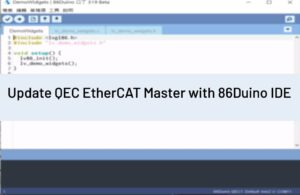[EthercatDevice_QECRXXHU]
Description
Specify the EC-Slave number and mount it on the EC-Master.
Class Modules
class EthercatDevice_QECR11HU5S; /* MPG + Keypad + LCM + RS232x2, RJ45 power [1, 1] */ class EthercatDevice_QECR00HU5S; /* MPG + Keypad + LCM + RS232x2, RJ45 power [0, 0] */ class EthercatDevice_QECR11HU9S; /* MPG + Keypad + LCM + RS232/485x2, RJ45 power [1, 1] */ class EthercatDevice_QECR00HU9S; /* MPG + Keypad + LCM + RS232/485x2, RJ45 power [0, 0] */
Format
int attach(uint16_t slave_id, EthercatMaster *master, EthercatAttachMode mode = ECAT_SLAVE_NO);int attach(uint16_t slave_id, EthercatMaster &master, EthercatAttachMode mode = ECAT_SLAVE_NO);
Syntax
EthercatDevice_QECRXXHU slave;
slave.attach(0, master);
Parameters
uint16_t slave_idECAT_SLAVE_NO: EtherCAT Slave Number.
ECAT _ALIAS_ADDRESS: EtherCAT Slave Alias Address.
EthercatMaster *master / &masterEthercatAttachMode modeECAT_SLAVE_NO
ECAT_ALIAS_ADDRESS
Returns
Int: 0 for successful; if the return value is smaller than 0 means an error.
Example
#include "Ethercat.h"
EthercatMaster master;
EthercatDevice_QECR00HU9S slave;
void setup(void) {
master.begin();
slave.attach(0, master);
master.start();
}
void loop() {}Libraries Reference Home
The text of the 86Duino reference is a modification of the Arduino reference and is licensed under a Creative Commons Attribution-ShareAlike 3.0 License. Code samples in the reference are released into the public domain.



